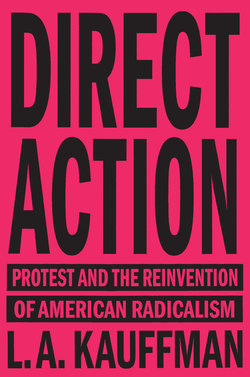Three Essays on the Theory of Sexuality

Реклама. ООО «ЛитРес», ИНН: 7719571260.
Оглавление
Sigmund Freud. Three Essays on the Theory of Sexuality
DIRECTACTION. Protest and the Reinvention. of American Radicalism
Contents
Introduction
1. Mayday
2. Small Change
3. In Your Face
4. Turned Up
Acknowledgments
Notes
Index
Отрывок из книги
L.A. Kauffman has spent more than thirty years immersed in radical movements as a participant, strategist, journalist, and observer. She has been called a “virtuoso organizer” by journalist Scott Sherman for her role in saving community gardens and public libraries in New York City from development. Kauffman coordinated the grassroots mobilizing efforts for the huge protests against the Iraq war in 2003–04. Her writings on American radicalism and social movement history have been published in The Nation, n+1, The Baffler, and many other outlets.
Armando Perez (1948–1999)
.....
The Days of Rage were widely viewed as a disaster. The tiny turnout was a fraction of what the Weather organizers had expected; the street fighting left most participants injured or jailed or both, with little or nothing to show for their bravado. When mainstream figures like former Supreme Court Justice Arthur J. Goldberg denounced the actions as “vandalism and hooliganism without a program,” many on the left agreed. The tactics used, Dave Dellinger of the Chicago 7 later wrote, “proved counterproductive in terms of their results—injuries, military defeat, an unsatisfactory choice at the end of the action between long prison sentences or enforced [time] underground, and unnecessary alienation of a potentially sympathetic public.” Some months later, one anonymous Weather sympathizer calling herself “a daughter of the Amerikan Revolution” published an essay on affinity groups in a spring 1970 issue of the radical Berkeley Tribe, endorsing their use for armed struggle. “The term ‘affinity group’ means different things to different people,” she explained, “anything from a group of people that run together in a riot to a basic armed unit for the revolution, which is my conception of it.” But already by 1970, even some of those who had flirted with street violence were concluding that rioting and armed struggle were dead ends for the movement, relegating activists to a terrain in which they could always be overpowered by the police or the military, while undermining their moral authority in the process. Affinity groups had proven too useful in practical terms to be abandoned—“they are to many people’s minds both safer and more politically acceptable than the marshal system for organizing participants at a demonstration,” an organizing manual of the period explained—but their significance and function began to change. 27
“The reason it changed, and went from a violent to more of a nonviolent kind of thing,” said Jeff Jones, “is because violent street fighting played itself out kind of quickly. We took it to the max at the Days of Rage, and the price was too high, and everybody knew it.” By the time the Mayday Tribe put out its call to protest, the concept of affinity groups had begun to blend with the other small-group forms that were rapidly growing in countercultural popularity: collectives, communes, cooperatives, consciousness-raising groups. Perhaps there was still a slight frisson of clandestinity attached to the use of affinity groups, given the sense among many that “Mayday was sort of the above-ground Weatherpeople,” in the words of John Scagliotti, who worked as a full-time staffer in the DC office for the action. And certainly the impulse toward direct physical confrontation with authority would remain a recurring (and constantly debated) element of disruptive protest for decades to come. But on the whole, affinity groups were coming to be seen as more expedient and sociable than paramilitary or insurrectionary. “Affinity groups at Mayday,” remembered John Froines, another Chicago 7 defendant centrally involved in the action, “were both a tactical approach in terms of the street and also something more, connected to people’s linkages to one another.”28
.....